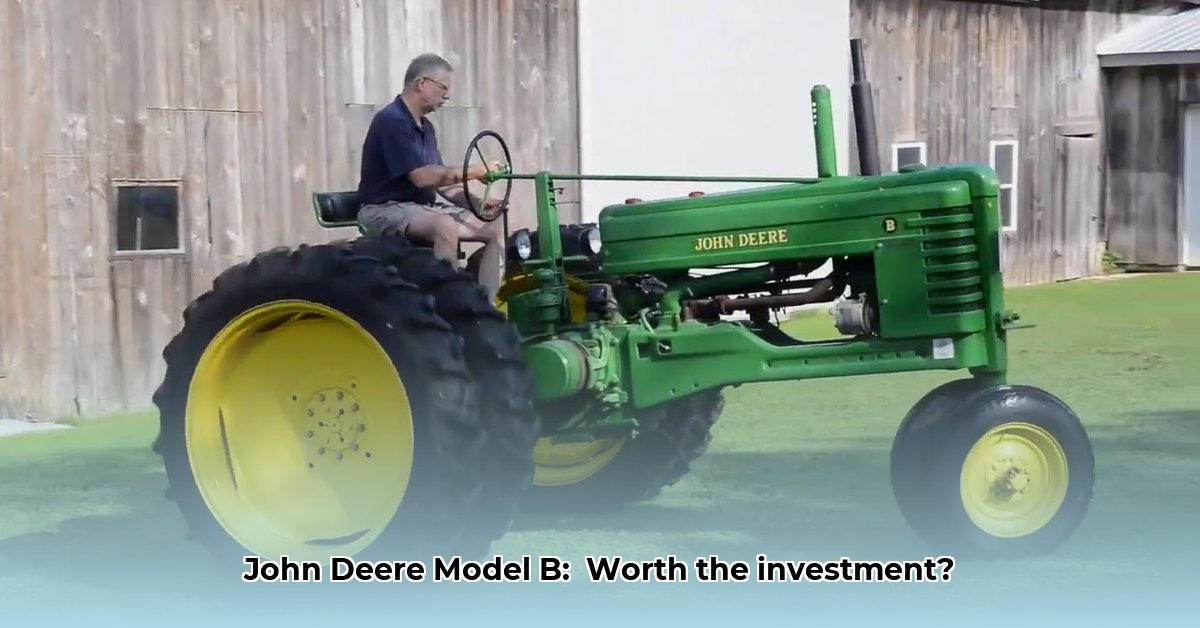
Finding the perfect classic John Deere Model B tractor can feel like searching for a hidden treasure. This comprehensive buyer's guide will equip you with the knowledge to confidently navigate the vintage tractor market, ensuring your investment is both rewarding and worthwhile. Whether you're a seasoned collector or a newcomer to the world of classic farm equipment, this guide provides the actionable intelligence you need to acquire your dream Model B. For even more in-depth information, check out this Model B resource.
Production Eras and Styling: A Timeline of Design
The John Deere Model B's production run spanned nearly two decades, resulting in three distinct eras, each impacting the tractor's value and desirability. Understanding these distinctions is crucial for any potential buyer.
The Unstyled Era (Pre-1939): These early workhorses represent the purest form of the Model B. Their simple, utilitarian design, coupled with their rarity, commands top dollar among collectors. Finding one in excellent condition feels like unearthing a historical artifact.
The Early Styled Era (1939-1947): Subtle but significant design refinements mark this era. These tractors maintain the classic John Deere aesthetic while reflecting advancements in manufacturing and aesthetics. They remain highly sought after but generally fall within a more accessible price range compared to their unstyled predecessors.
The Late Styled Era (Post-1947): These models represent the pinnacle of the Model B's design evolution, integrating more advanced features and a refined aesthetic. While less rare than earlier models, their functionality and style continue to attract enthusiasts.
(Include images illustrating each of the three production eras here)
Key Features and Options: What to Look For
Several key features significantly influence a Model B's value and overall desirability. Recognizing these features will help you make informed decisions and identify the most valuable options available.
Synchronized Transmission ("Synchro"): This feature provides significantly smoother and easier gear shifting, a highly prized characteristic that dramatically increases value. It's the difference between a frustrating experience and a smooth, efficient operation.
Rear Remote Hydraulics: This allows for connecting various implements (plows, harvesters, etc.), enhancing versatility and significantly boosting the tractor's worth. It opens up a world of possibilities for any prospective owner.
Original Engine and Components: A Model B with its original, well-maintained engine and components is a true prize. The presence of original, unrestored parts is a valuable indicator of both condition and authenticity. These original components represent a significant investment and history.
(Include images highlighting the synchronized transmission and rear remote hydraulics here)
Price Variation and Market Trends: Understanding the Market
The price range of a John Deere Model B is extensive, spanning from several thousand dollars for a project tractor requiring extensive restoration to well over $10,000 for meticulously restored showpieces. This wide variation is due to several key factors:
Condition: A pristine, well-maintained tractor will always command a higher price than one that shows significant wear. It's similar to the used automobile market; condition is paramount.
Rarity: Pre-war models are particularly rare and hence more valuable. The earlier the model, the higher the potential cost.
Features: Tractors equipped with desirable features like the synchro transmission and rear remote hydraulics fetch higher prices. These additions offer enhanced functionality and value.
Horsepower Discrepancies: Expect inconsistencies in advertised horsepower ratings due to historical variations in testing methods. Don't let this minor detail impact your decision.
(Include images showcasing John Deere Model B tractors spanning the various price ranges here)
Condition Assessment: A Detailed Inspection Guide
A thorough visual inspection is crucial before purchasing a John Deere Model B. Here's a step-by-step approach to ensure you're making an informed choice.
Body: Examine the paint, rust, and overall structural integrity. Look for excessive rust as a clear sign of neglect.
Engine & Transmission: Inspect for any leaks, wear, damage, or unusual noises. The operational condition of these crucial components heavily affects the value.
Mechanical Components: Check all moving parts – from the steering to the hydraulics – for wear and damage. Replacing damaged components can be expensive.
Tires: Assess the condition and wear of the tires. New tires add significant cost, indicating less overall value in a used tractor.
(Include images illustrating examples of both good and poor condition here)
Finding and Buying a John Deere Model B: Where to Start Your Search
Your search for a John Deere Model B can lead you to many different places. Begin your search by exploring these avenues:
Online Marketplaces: Websites specializing in vintage tractors and agricultural equipment are excellent starting points.
Auctions: Agricultural auctions often feature classic tractors, providing opportunities to find unique specimens.
Local Classifieds: Don't underestimate the potential of local advertisements or community forums where you might discover a hidden gem.
Essential Questions to Ask Potential Sellers:
- What's the tractor's documented history?
- What maintenance has been performed and documented?
- Are there any known issues or problems with the tractor?
- When was the last engine overhaul? Were original parts used?
- Are all the parts original or have they been replaced?
Thoroughly research sellers' reputations before committing to a purchase.
Restoration and Maintenance: Keeping Your Investment Thriving
Restoring and maintaining a John Deere Model B requires specialized knowledge and resources. Numerous online communities dedicated to John Deere tractors, along with many specialized parts suppliers, provide invaluable support and resources.
Conclusion: Making an Informed Decision
Purchasing a John Deere Model B requires careful consideration. A thorough understanding of the different production eras, key features, and condition assessment plays a significant role in making a sound investment. By using this buyer's guide, you can confidently approach the process and secure your dream classic tractor.